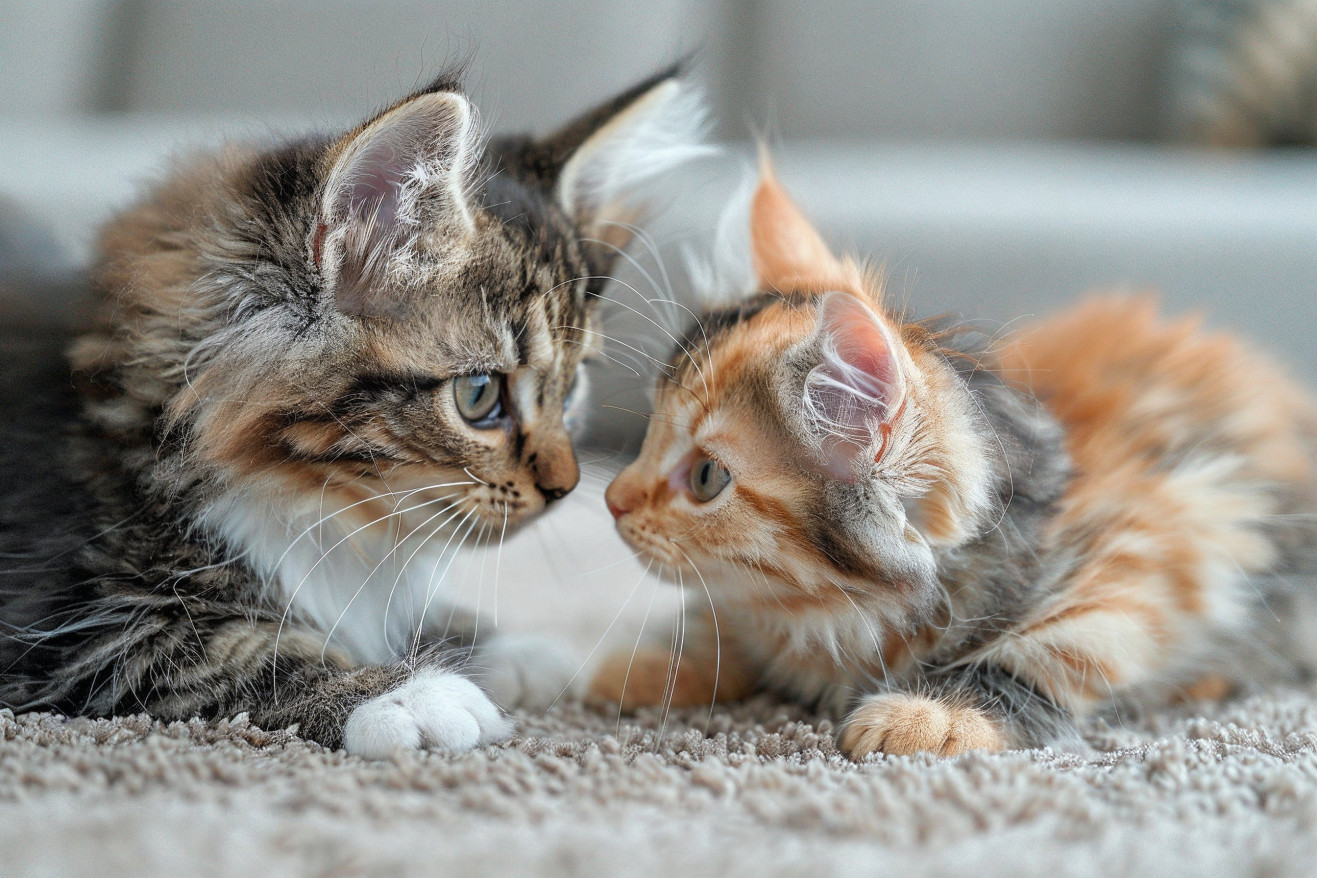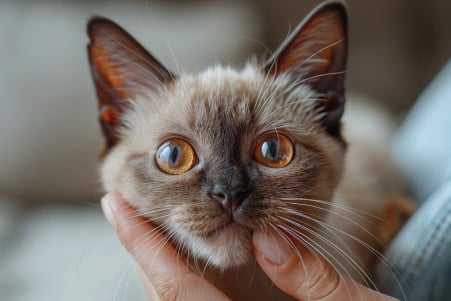Why Does My Cat Bite My Other Cat's Neck? Understanding Aggression
7 June 2024 • Updated 7 June 2024

Neck biting and body biting in cats is a normal part of play and a way to assert dominance, but it can also lead to more serious fighting. While some neck biting is normal, if your cats are constantly chasing and attacking each other, it could be a sign of a bigger problem. This could be due to stress, lack of resources like food/water bowls or litter boxes, redirected hunting behavior, or lack of proper cat introductions when a new cat was brought home.
To help you better understand and address this issue, we'll review research from animal behaviorists and veterinarians who have studied the causes of aggression between household cats. Their work will help you learn how to reduce stress, provide environmental enrichment, and set up your home for a successful multi-cat environment. The result is that you'll be able to help your cats stop biting each other too much while still allowing for normal play and grooming.
Why does my cat bite my other cat's neck?
What Neck Biting Means in Regular Cat Behavior
Neck biting is a common part of a cat's social interactions and can be seen in a variety of situations, including mating, playing, hunting, and establishing social hierarchies. For example, as noted by Cats.com, when mating, male cats will often bite the female cat's neck to show dominance and keep her in place while protecting themselves from attack when they are most vulnerable. Meanwhile, as pointed out by Catster, mother cats will gently bite their kittens' necks to pick them up or get them to comply with being groomed, which is a way of showing dominance.
As Hepper explains, kittens and adult cats often play fight and bite each other's necks as a way of practicing hunting and learning important skills. While play neck biting is generally not aggressive, it helps cats learn to stalk, pounce, and immobilize their prey. In fact, neck biting is an effective hunting strategy that allows cats to quickly take down their prey by attacking this vulnerable area.
While some neck biting between cats in the same household is to be expected and is harmless, excessive aggressive biting, chasing, and attacking can be a sign of a problem that needs to be addressed. Knowing the situations in which neck biting is likely to occur, including play, mating, social hierarchy, and hunting practice, can help cat owners tell the difference between problematic aggressive behavior and normal cat behavior. This can help them better deal with excessive neck biting while still allowing for normal interactions.
Allogrooming and Social Bonding: The Role of Neck Biting
Cats lick and groom each other in a behavior called allogrooming. While this behavior is a form of communication, a sign of affection, and a way to remove parasites, allogrooming is also an important bonding behavior, especially for littermates and mothers with kittens, and can help with comfort, self-grooming, and scent exchange, according to AmeriVet.
Research on cat colonies has shown that more allogrooming occurs when there are more cats in the colony and less aggression between them, and that dominant cats are more likely to groom less-dominant cats, as noted in a study in the Journal of Veterinary Behavior. Meanwhile, male cats are more likely to initiate allogrooming, and allogrooming is usually performed by one cat on another, with the recipient often being groomed on the head and neck, according to Catster.
In addition to helping cats avoid aggression and maintain social bonds, allogrooming, especially of the neck area, can also be used to reinforce social hierarchies. As the Catster article notes, this type of allogrooming may indicate that the cats involved are closer than others in the colony and use grooming as a way to communicate and bond.
Aggressive Neck Biting: Causes and Triggers
While some neck biting is normal, excessive or aggressive biting, chasing, and attacking between household cats can indicate underlying issues. According to The Spruce Pets, territorial aggression can occur when a cat feels its territory has been invaded, such as when a new cat is introduced or a young cat reaches maturity.
Inter-male aggression involves posturing, stalking, yowling, and fighting, often over access to females or resources, as described by the Dumb Friends League. Other triggers for aggressive neck biting include boredom, overstimulation, redirected hunting behavior, fear, or medical issues, according to PAWS.
Sudden changes in neck biting behavior may signal an underlying medical problem that should be addressed by a veterinarian. By understanding the various causes and triggers of aggressive neck biting, cat owners can take steps to manage this behavior and create a more harmonious multi-cat household.
How to Prevent and Manage Aggression and Neck Biting in Multi-Cat Households
Properly introducing new cats and ensuring that there are enough resources to go around can help prevent inter-cat aggression and neck biting. According to The Spruce Pets, if aggression does occur, it's important to figure out the cause, make sure that each cat has their own resources, and then reintroduce the cats slowly using positive reinforcement.
As noted by Jackson Galaxy, owners should not let the cats work out their issues or punish them, as both of these things can make the situation worse. Instead, they should separate the cats when they fight and then get help from a professional. Meanwhile, play therapy, environmental enrichment, and systematic desensitization can help manage aggression and prevent neck biting, according to The Regina Humane Society.
In some cases, medication can be used in conjunction with behavioral therapy, but it's not a long-term solution by itself, according to the Regina Humane Society. With the right knowledge and management techniques in place, cat owners can ensure that their multi-cat households are peaceful and that neck biting is kept to a minimum.
How to Introduce a New Cat: Tips and Techniques
It is important to take your time when introducing a new cat to one or more cats that already live in your home. This will help the cats feel more comfortable and reduce the likelihood of aggression. According to PetMD, the new cat should be kept in a separate room at first, with their own resources, and given time to get used to their new surroundings.
Positive associations should be made by giving treats when the cats are near each other, and then gradually moving them closer together, as per Jackson Galaxy. Once the cats are used to each other, they can be allowed to interact under supervision, with treats given for good behavior, according to The Humane Society of the United States.
Increasing territory by adding vertical space, using pheromone diffusers, and making sure that each cat has their own resources can also help reduce conflict, according to The Humane Society. With time and careful attention to the introduction process, cat owners can help their new and existing cats learn to live together in harmony.
Conclusion: How to Help Cats Get Along
While neck biting is a normal part of a cat's play behavior and a way to establish dominance, it can also be a sign of aggression. Excessive neck biting, chasing, and attacking between cats in the same household is a sign of a problem. Stress, lack of resources, redirected hunting behavior, and improper introductions are all potential causes of excessive neck biting between cats in the same household.
According to American Humane, it is strongly recommended to adopt from a local animal shelter rather than a pet store. If adopting a specific breed, they advise finding a reputable breeder. When selecting a new cat, the focus should be on personality matching to ensure compatibility with the resident cat.
The introduction process should start by trading scents between the cats, preparing a separate room for the new cat, and allowing them to make visual contact through a gate before supervised physical access. International Cat Care emphasizes the importance of using synthetic feline pheromones, maintaining separate resources, and gradually increasing unsupervised time together.
As explained by Anti-Cruelty, the initial separation and introduction should be done calmly and gradually, with positive associations like treats. Hissing and light swatting are normal, but any signs of serious aggression require immediate separation and a slower reintroduction process. Patience and professional guidance are key to a successful multi-cat household.


